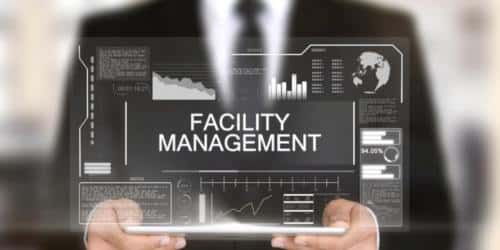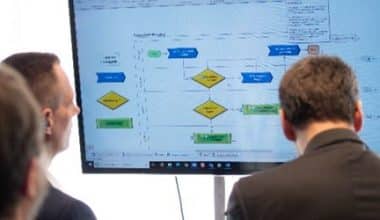Whether you run a construction site, factory, educational institution, or business office, you will undoubtedly face several maintenance and organization issues. This is what property management solutions are for to assist facility managers and entrepreneurs in ensuring that their buildings are always in tip-top shape and are being maximized. We have compiled a list of the best facilities management software to help you begin your search. This should give you a better perspective on what to expect when browsing for one.
What is Facility Management Software?
Facility management software assists businesses in managing the lifecycle of industrial buildings such as warehouses, distribution centers, manufacturing sites, oil refineries, and processing plants. This sort of software includes routines for identifying and monitoring all of a company’s facilities. It also aids maintenance crews in identifying and carrying out inspections and repairs to keep each location in excellent working order.
A facility management system, as opposed to generic maintenance management software such as computerized maintenance management systems (CMMS) and enterprise asset management (EAM) software, focuses solely on facility maintenance. This software is not to be confused with property management software used in the real estate business.
What Types of Facility Management Software Exist?
Facility management software is classified according to how it is sold, implemented, and used.
#1. Standalone or part of EAM
Many EAM and CMMS software solutions incorporate facility management functions, but there are other systems created particularly for this purpose.
#2. Cloud or on-premises
While the majority of facility management solutions are hosted in the cloud, certain older systems are housed on the customer’s premises. Facility management software can be installed both on-premises and as a software-as-a-service (SaaS) model in some circumstances.
#3. Agnostic or industry-specific
Most facility management solutions cater to many industries, however, other systems specialize in a single industry, such as retail, manufacturing, or healthcare.
What are the Common Features of Facility Management Software?
The following are some key characteristics of facility management software that assist businesses in making the best use of their facilities:
#1. Asset management
Facility management software, as opposed to CMMS and EAM software, focuses on building and building structures that a corporation can employ to accomplish operations. Each construction contains many systems, such as ventilation, air conditioning, and power.
#2. Work order management
Facility maintenance necessitates procedures such as inspections and repairs, which are managed through work orders. Work orders specify the sort of activity to be completed, as well as how and by whom. Orders are assigned to technicians depending on their qualifications and availability. Managers plan and track the status of all orders placed by a team, location, or personnel.
#3. Cost and spend tracking
Facility management software allows customers to track maintenance expenditures such as technician time spent on various procedures and the cost of spare parts and consumables needed to keep facilities in good working order. Some examples are industrial lighting equipment and building maintenance materials.
#4. Procurement and vendor management
Facility managers collaborate with suppliers of parts and accessories, and they may outsource maintenance activities to other organizations. As a result, finding dependable and cheap vendors who offer high-quality products and services is vital.
#5. Analytics
Metrics and analytics assist facility managers in tracking and monitoring the efficiency of maintenance activities. Data recorded by sensors and meters in numerous locations can also be used by facility management software.
What are the Benefits of Facility Management Software?
Using software to manage facilities offers numerous advantages, the most prominent of which are:
#1. Maintenance cost savings
Planning maintenance operations with software can enhance resource allocation and labor productivity, resulting in cost savings. Reduced response time for service calls and higher facility uptime are two examples of cost reductions.
#2. Enhance operations
Maintaining buildings may be a difficult chore, especially when a company has many locations spread across the country or even the world. Inventory management and maintenance scheduling, for example, make it easier for facility managers to plan and manage operations.
#3. Improve facility performance
Facility management software helps reduce downtime and interruptions in facilities, resulting in improved performance and efficiency. For example, a warehouse that cannot be used to its full capacity jeopardizes the company’s ability to ship and receive products quickly.
Best Facility Management Software of 2023
We have carefully identified the best facilities management software available on the market to assist you in your search for one that can meet the needs of your firm. The products listed below were chosen for a variety of reasons, including their ease of use, flexibility, scalability, and feature set. They are as follows:
#1. FMS:Workplace
FMS:Workplace is a facility management system designed to assist enterprises in making the most of their work environments and assets. It offers powerful visualization and planning capabilities, as well as reporting options, to help you gain data-driven insights into how you use your facilities. Scenario planning, sustainability financial forecasts, environmental effect analysis, building evaluation tracking, and lifetime planning are some of its characteristics. It also includes built-in service request management solutions.
#2. Hippo CMMS
Hippo CMMS is a robust but easy-to-use maintenance management solution. This multi-award-winning web-based software is suitable for a wide range of industries, including manufacturing, healthcare, education, hospitality, and many more. It is designed to assist facility managers in maximizing assets, ensuring compliance, and lowering maintenance expenses.
Hippo CMMS provides three pricing options: Hippo Starter ($39/month), Hippo Plus ($69/month), and Hippo Pro ($99/month).
#3. eMaint
eMaint is a computerized maintenance management system (CMMS) designed for small and medium-sized organizations. It combines functions such as preventive maintenance, predictive maintenance, inventory management, supplier management, and work order management into a single hub, allowing users to easily optimize business processes. Furthermore, because it includes bespoke reporting options, firms may simplify data analysis while keeping a close eye on day-to-day operational performance.
#4. UpKeep
UpKeep is the first mobile-first facility and asset management maintenance solution. This CMMS, which is trusted by over 50,000 users worldwide, including Unilever, Yamaha, McDonald’s, and the USDA, can handle all of your work order management, task scheduling, barcode scanning, and inventory management requirements. UpKeep is great for small enterprises and startups because its basic capabilities allow you to handle as many work orders as you want for free.
As your company expands, you may decide to commit to subscription plans in order to have access to its advanced features.
#5. Skedda Bookings
Skedda Bookings is a facility management tool designed to make facility bookings easier. This system is ideal for handling meeting rooms, sports arenas, professional studios, or coworking spaces, and it is known for its strong data security requirements, high uptime and performance, and excellent customer service. The sole disadvantage of using this program is that it may not be suitable for businesses searching for comprehensive facility management tools because it lacks compliance solutions and service request systems.
#6. FMX
FMX is a cloud-based computerized maintenance management system that, with its user-friendly interface and customizable modules, simplifies facility administration. It is a terrific tool used by respected firms such as Avon, Wendy’s, Taco Bell, and the USDA that may speed up the operations of schools, manufacturing factories, property management companies, and restaurants.
Maintenance tracking, asset management, and room and resource scheduling are among its many purposes. FMX is available on all desktop and mobile devices and has different price levels depending on your company’s demands.
#7. Nexudus Spaces
Nexudus Spaces is a white-label tool designed to assist entrepreneurs in the management of coworking spaces. This sophisticated facility management application, developed in 2012, allows customers to manage bookings, produce invoices, and even list events and sell tickets online. It is a fully integrated solution that includes access control and security features to safeguard your data. To make invoice generation easier, the system supports over 50 payment providers.
Nexudus Spaces is eternally free for up to 5 active members; 6-40 users must pay $85 each month. If you plan on enrolling more members, Nexudus Spaces has a price calculator on their website.
#8. OfficeSpace Software
OfficeSpace Software is a straightforward facility management tool designed to enable users to manage their space with ease. This software, which provides a package of solutions that can function together seamlessly, allows you to eliminate error-prone manual processes in favor of faster and more updated strategies. This mobile-ready platform’s most significant features include real-time business intelligence, reporting and analytics, and request management solutions.
If you are interested in this platform, OfficeSpace Software can be obtained on a quote basis. The cost will be determined by the number of seats in your organization.
#9. Quick Base
Quick Base is a no-code facilities management tool that seeks to improve operational efficiency and concentrate critical company information. It reduces your workload by storing, tracking, and managing data on a single platform. This system is mobile-ready and extremely scalable, and it is also designed to automate manual tasks with best-in-class technologies. It includes asset monitoring, inventory management, and maintenance request management as features, making it one of the most comprehensive programs for facility management systems.
#10. Prodsmart
Prodsmart is primarily intended for production management. It streamlines all production-related activities for faster workflows while guaranteeing that each output consistently meets high-quality requirements. This software connects data from your manufacturing plants to your back office, providing you with accurate data in real time.
It also gives you a visual picture of your production floor, complete with a comprehensive dashboard that allows you to observe and alter jobs, timetables, and other responsibilities as needed.
#11. Infraspeak
Infraspeak is a piece of maintenance software designed to improve technical operations. It is simple to set up, completely versatile, and unique, with capabilities spanning from building management to maintenance planning. Furthermore, this facilities management system is used by multinational businesses, giving you confidence that you are investing in dependable software.
#12. 360Facility
360Facility is a cloud-based software solution used by over 10,000 customers in over 150 countries to improve operational functionality. It can meet the complicated needs of certain industries such as corporate real estate, healthcare, higher education, government, retail, telecommunications, and utilities. The platform includes property management, asset maintenance, and real-time reporting features to help you quickly discover issues in your facilities and take corrective action before they worsen.
#13. WebCheckout
WebCheckout is an all-in-one asset management tool that allows you to manage all elements of your resources. It combines specialist tools and single-purpose apps to optimize and streamline your operations, from installation, inventory planning, and monitoring to maintenance, repairs, and decommissioning. This browser-based and mobile-ready technology also includes user-friendly dashboards and digital calendars to supplement your planning efforts.
What Is the Software for Facility Management?
There is a plethora of applications available, and you may easily select one from our list above. FM software allows firms to manage their whole repair and maintenance program via a web-based dashboard.
What Is Cafm and Cmms?
CAFM is an abbreviation for Computer-Aided Facility Management, and CMMS is an abbreviation for Computerized Maintenance Management System. Although these two digital platforms share some similarities, it is critical to learn how to differentiate them and the purpose of each software.
What Is the Use of Facilities Software?
A facilities management software solution enables firms to manage their whole repair and maintenance program, saving time and money by more efficiently and effectively managing their buildings, assets, and occupants.
How Much Is Cafm Software?
CAFM Explorer is a premium product that starts at $2000 and is suitable for any size business. CAFM Explorer can be implemented both online and on-premises, and it is available on a variety of platforms, including Windows and Linux devices.
What Is the Strongest Tool of a Facility Manager?
One of the most useful tools to use is an inventory management system. These systems enable facility managers to use barcodes to maintain inventory, pinpoint the exact location of stocked objects, and assess how frequently they are used.
What Does Cafm Stand For?
CAFM stands for Computer Aided Facility Management.
What Are the Benefits of Cafm Software?
CAFM software assists managers in making the most use of their time while planning and prioritizing tasks. CAFM software’s core benefits include coordinating teams and workloads, providing excellent customer support, and monitoring compliance and performance levels by automating procedures related to all of these criteria.
How Do I Choose a Cafm?
The following factors should be considered while selecting a CAFM system:
- DEFINE your business and stakeholder needs.
- DELIVER the right CAFM to empower your FM team.
- SUPPORT them as they take your business to the next operational level.
Conclusion
Without a doubt, facility management solutions can easily assist you in increasing the efficiency of your facilities while lowering operating costs. You can quickly improve the way you make business decisions by implementing one for your firm. All you have to do is decide which one best suits your specific needs and interests. Hopefully, our list of the top 13 facilities management software helped you get started on your search.
Related Articles
- CONTRACT LIFECYCLE MANAGEMENT: The Ultimate Guide to CLM
- WHAT IS A CONTENT MANAGEMENT SYSTEM (CMS)
- MANAGEMENT CONSULTING FIRMS: Best US Consulting Firms 2023
- CREDIT MANAGEMENT SYSTEM: What It Is & Why It’s Important






